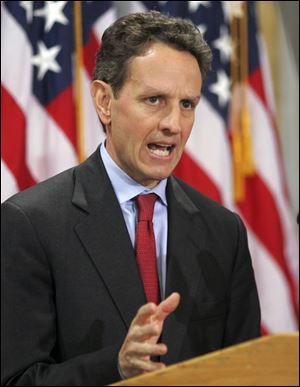
Bailout asks $2.5 trillion
2/11/2009
Treasury Secretary Timothy Geithner maps a bigger government role in banking.
WASHINGTON The White House plan to rescue the nation s financial system, announced yesterday by Treasury Secretary Timothy Geithner, is far bigger than anyone predicted and envisions a far greater government role in markets and banks than at any time since the 1930s.
Obama Administration officials committed to flood the financial system with as much as $2.5 trillion with $350 billion of that from the bailout fund and the rest from the Federal Reserve and private investors.
Mindful of previous financial crises at home and abroad that became protracted because governments moved too slowly, Mr. Geithner pointedly criticized the Bush administration for not acting boldly and quickly enough.
But the initial assessment of the plan from the markets, lawmakers, and economists was negative, in large part because they expected more details.
Basic questions about how the various parts of the program would work, especially those involving the unsellable mortgages that banks are holding and preventing home foreclosures were left for another day.
Some Wall Street experts criticized the plan for relying too heavily on the same vague solutions proposed by the Bush administration.
The stock market, propped up for weeks on the expectation that Washington would finally deliver a comprehensive rescue plan, dipped almost as soon as Mr. Geithner began speaking in the morning, with the Dow Jones industrial average falling 382 points, or 4.6 percent, by the time the market closed.
Yields on Treasury bills jumped, indicating a flight from stocks to the safety of government bonds.
While traveling in Fort Myers, Fla., President Obama dismissed the market reaction to his bank rescue plan. Wall Street, I think, is hoping for an easy out on this thing and there is no easy out, Mr. Obama said in an interview with ABC
News.
Many of the vital details of the program remain unsettled, and are the subject of an intense behind-the-scenes debate.
A central piece of the plan and the one item that investors most craved information about would create one or more so-called bad banks that would rely on taxpayer and private money to purchase and hold banks bad assets. But the administration provided the least amount of details about this part of the plan.
Another centerpiece of the plan would stretch the last $350 billion that the Treasury has for the bailout by relying on the Federal Reserve s ability to create money, in effect, out of thin air. The Fed s money will enable the government to become involved in the management of markets and banks in ways not seen since the Great Depression.
In the credit markets, for instance, the Obama Administration and the Fed are proposing to expand a lending program that would spend as much as $1 trillion to make up for the $1.2 trillion decline between 2006 and last year in the issuance of securities backed primarily by consumer loans.
The plan s third major component would give banks new helpings of capital with which to lend. Banks that receive new government assistance will have to cut executive salaries and perks and sharply limit dividends and corporate acquisitions.
They will also have to make public more information about their lending practices.
The day marked the first big test of Mr. Geithner as Treasury secretary, who has one of the toughest sells in America: convincing lawmakers and taxpayers that they should again bail out the very banks whose mistakes contributed to the loss of more than 3 million jobs and caused acute financial pain.
It was clear during the hours he spent before the cameras and lawmakers that he was well spoken. But as the day wore on, Mr. Geithner faced growing skepticism from lawmakers.
Even Democrats who are supportive of the administration said it had failed to provide more information about how it would be spending the remaining money in the bailout program.
The pessimism seemed to indicate that Mr. Geithner missed the mark with one of his shorter-term goals to quickly instill confidence that the Obama Administration has a coherent approach to the banking crisis, and that the transparency and oversight of the new program will differ markedly from the Bush administration s management of the first $350 billion that Congress authorized last year for the Troubled Asset Relief Program, or TARP.